The Camino de Santiago Part 4: The Way to Santiago
…continued from Part 3: Crossing the Meseta
I have been hiking all day on a winding mountain road past little towns, highland farms, and wandering cattle. The terrain – and the weather for that matter – is a welcome change from the continuously flat Meseta and its April showers that consumed the last week of my life. I’m a few miles out from the Cruz De Ferro, an iron cross standing at the top of the pass just after the hillside village of Foncebadón. I check into an aubergue after a hard day uphill.
Many pilgrims regard the Cruz De Ferro as an important place to address the burdens in their lives, symbolized by a stone that each person brings with them on their journey. They hike for hundreds of miles, carrying their stones and the emotional weight of their hardships that it represents to this summit, cast their burdens at the foot of the iron cross, and continue on, hopefully in a better state of mind and heart. I too had my stone that I carried with me up this mountain. In my case, my burden was guilt.
There was a family dog who I neglected in my teenage years when he needed me. We didn’t know how to handle such a wild dog back then, so we left him chained up in the yard most of the time and I became busy with other matters. Eventually my family brought him in the house when he was older and calmer, but it was long after I had left. Only later in life did I realize the weight of my mistake – not being part of his life – far later than I would ever have the chance to repair.
Before I started my journey, I went to his burial site at the family farm and picked up a stone. I have carried it with me, and the weight of my guilt, on the Camino since the very beginning. Now, standing at the cross at the top of the mountain, I take it out, determined to never treat another family pet, or any animal, like that ever again and I cast it onto the pile.



The descent from there into the Ponferrada valley entails about three hours of steep, rocky downhill trails before leveling off at the valley floor. It isn’t much fun, but the view is great and the morning is pleasant. Flowers appear along the forests, soon blooming across entire hillsides. I try my best to enjoy the morning without twisting my foot on the rocky trail. I reach the bottom and stay in Molinaseca at the valley’s eastern edge for a night and then continue across the valley for an entire day through Ponferrada’s city centre, going west to the postcard town of Villafranca. The path leads me through gentle rolling hills, vineyards, and hazy mountains in the distance.
I meet Becky from LA, eating dinner by herself at a terrace and just starting her Camino. She has questions about logistics, like how easy is it to find available aubergues, should she make reservations, what the heck is she doing out here, etc. I was nervous on my first day too. Next morning, she already passes me at a faster pace. She’ll be fine.







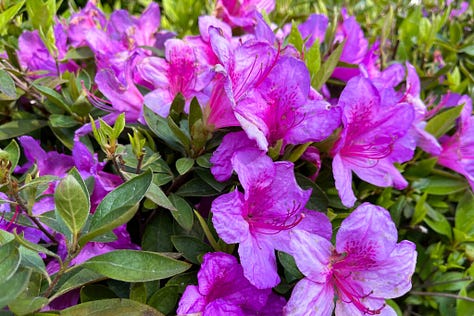

After Villafranca and its beautiful Castillo, the trail follows a rushing creek along another big uphill ascent to O’Cebreiro, the second highest point of the Camino. Leaving the main road behind, I hike steeply up a large ridge for about three hours, soon revealing spectacular views of the valleys below. The Galician border is marked by a large sign at the summit of the pass. Becky catches up and we team up, hiking in and out of the mountaintop clouds before we reach her planned stopping point. I stay in the next town after and we keep going west the next day, hiking downhill out of the mountain fog.
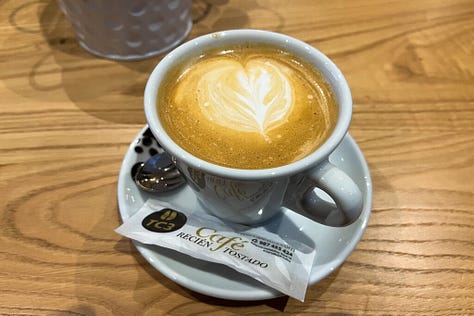






Something dawns on me as I descend on the western side of the pass, going by countless villages and tattered yellow arrows: For the first time ever, Santiago is about a week away. This place that I spent years dreaming about was actually materializing – the end of all of this, by the gods, is in sight. And I don’t know how to handle it. Because up until now, I have been dealing with nothing but frustrating delays and setbacks.
For seven years, ever since I briefly dated somebody who hiked it, I was fixated on the idea of doing the Camino myself. I started learning about it, obsessively watched Youtube videos, and even bought a guidebook and outlined it at one point. My obsession snowballed into my first nervous decision to travel to Spain in 2018. Unfortunately, I realized then that I didn’t have the money to take the trip after paying for some unexpected dental work. I couldn’t meet the budget at that time, and I don’t travel in the red.
I tried again in the following spring, but canceled my trip last minute because I couldn’t find comfortable hiking shoes to work with my widening left foot. It’s possible that I could have used what I had for distance hiking, but I’ll never know. It was a situation fraught with anger and disappointment. Instead, I traveled around Europe for three weeks, visiting different countries as a contingency. To an extent the unexpected micro-adventures brought comfort and healing, but it wasn’t where I really wanted to be.
The third time I attempted the Camino was in the fall of 2019. I successfully hiked for the first third of the trek, finishing at Burgos with the intent on returning the next year to reach the end. Unfortunately, I didn’t have the foresight to anticipate an imminent global health crisis that might well complicate my plans.
The fourth attempt was derailed in 2020 by worldwide Coronavirus lockdowns.
And the fifth time? Well, that was my decision. It was the fall of 2021 and tourism was allowed again in varying degrees between America and the EU. The problem was that even though travel was allowed for vaccinated tourists, I could still be exposed to the virus – and if so, be required to quarantine for 10 days in a hotel. But where? How does it even work if I catch the virus in a remote village without any hotels? Further, I would also need a negative Covid test to return to my own country. And if it fails, I could end up in Quarantine Gulag for that as well.
It led me to the conclusion that we as nations really didn’t have a grip on this problem yet. And places like Spain were allowing just enough people to keep their tourism industry from collapsing. Which I understood, but I realized I didn’t want to be dealing with so many unknowns. Is this how I’m supposed to travel now? Wondering if and when I get sick? As painful as it was to come to terms with it, I felt rushed and ultimately wrong in doing this. And so, once again, my Camino was delayed. This time by my own choosing.
And this time, I broke my own heart.
Well, that’s in the past. It’s a perfect sunny morning in the forest after Sarria. I got out of the mountains a few days ago and Santiago is closing in. Despite all of my sadness and hesitation, I’m not slowing down. Rather, I’ve been starting each day with a surge of pure energy. The weather is perfect and the hill country out here is gorgeous.




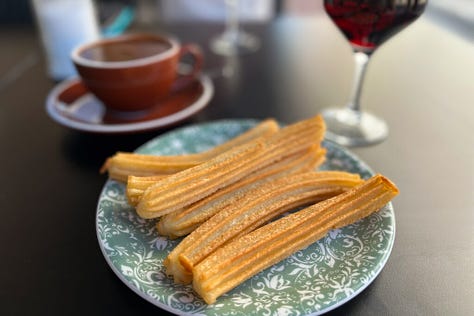
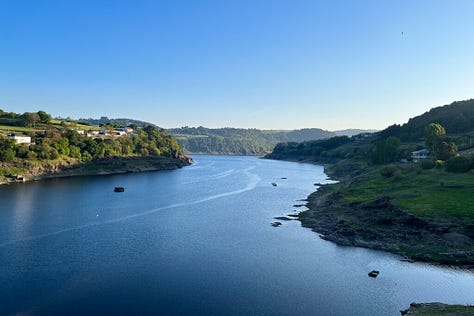
Galicia is noted for its lush forested hills, farms, and towns of ancient stone buildings - some converted for modern use, while others are left to crumble in time and the overgrowth of the woodlands. Going from to village to village each day, I’m reminded continuously that despite all of its modern advancements, Galicia bears the history of great kingdoms, old forests, and lovely hillside vistas that have stood throughout the ages. This place feels like a Shire by the sea.
The main cuisine out here is mariscos and pulpo caught from the coastal towns. That along with the local wines, which are always cheap, are perfect after a long hot day. I stop at the famous Pulperia Ezequiel in Melide, and then a cervezeria selling Pilgrim Beer, on my last day before reaching Santiago. Continuing past other bars and cafes, I see numerous people drinking together. They’re not in a hurry. Because tomorrow they will get to the end. And they don’t want tomorrow to come. They don’t want this dream to be over.
I keep seeing Becky, Ginger, Nick the Brit, the Canadian Ladies, and Dan the Storyteller, whenever I stop in the towns. I call him that because he started calling me Dan the Cowboy because of my hat. But every time I see him, he recalls some kind of interesting anecdote from the people he meets. He said he saw one guy on the trail with a cloth photo of a man’s face on his backpack. When he asked him what it was, the guy said it was a picture of his father. And that before this, his father had hiked the Camino eight times. This time would be his ninth.
Another time, Dan met somebody who was carrying a small pack over his chest. He told Dan that it was the ashes of his mother. That she always wanted to hike the Camino, and now they were doing it together.
Back in Villafranca, several of us shared a terrace behind an aubergue with a young Spanish lady and her father. She said that he was hospitalized a few years ago with a severe case of Covid that almost took his life. After he recovered, he said to her, “I want you to come with me on the Camino de Santiago.” And there they were.
And then there is the story that I heard from my archive of YouTube videos about a young woman from South Africa whose father was murdered right in front of her. For her, the Camino was her way of working through her trauma and healing from the pain.
I’m sure there are so many other tales like this. So many simple, genuine, broken people – in person or in spirit – who are out here on a journey for reasons that I will never know or hear of. But we each have something calling us to walk together on this ancient Way of Saint James, ultimately bringing us each to the outskirts of Santiago de Compostela. Here, I choose to spend the night in O Pedrouzo, a half days walk from the plaza.
And so, Santiago is finally in sight.









I start early the next morning, and whatever sadness and hesitation I felt about this place is gone. I’m charging harder than ever through the outer suburbs with an incredible rush of endorphins like I have never felt in my life, unable to slow down or stop. It feels like tsunami of energy is pushing me from behind. For four straight hours. My pack is the only reason why I’m not running.
Passing the outskirts of the city centre, I see Kirstie from Scotland, who for the last few days has been limping painfully on an overused, swollen ankle. I saw her early yesterday and was worried about her, but it looks like she’s about to hobble gloriously over the finish line. Which I understand. At this point, something has to physically stop us from reaching the end of this dream. We chat for a bit, and I tell her I’ll see her at the plaza.
HOLY SHIT!!! IT’S THE TOWERS!!!! The spires of the cathedral stand out above the rooftops. It’s only blocks away.
Finally, I descend a stairway and walk into the plaza below the façade of the mighty Santiago Cathedral, unable to hold back my tears. The towers cut sharply in the brisk morning sky. This whole place is full of pilgrims celebrating: relieved, sad, joyful, and victorious people pouring into the plaza all day long. I find a few of my trail friends near the middle, like Caleb the drinking Irishman, the Israeli who reminds me of Borat, and Becky and Ginger arriving soon after, and Kirstie, limping in pain and glory. Below the overpass coming into the plaza, a guy on a bagpipe starts playing Amazing Grace, and with it, a reminder of home. I’m losing it.
Santiago de Compostela was a lifetime away. But not anymore.
That night, pilgrims and locals of faith alike come together in the cathedral to attend the Pilgrim’s Mass. I don’t find out until later that the priest reads the name of each pilgrim who received their certificate at the Pilgrim’s Office in the last 24 hours, which must have included me. But I admire this immaculate, beautifully adorned sanctuary as he leads the congregation through each prayer from the high altar. I understand very little, and am certainly not familiar with any Catholic prayers and traditions, but I, a Pilgrim of the Camino, am welcome among them. The priest ends the mass with a beautiful prayer and blessing to the pilgrims.
I stay in Santiago another day, as some of my friends like Becky, Ginger, and Kirstie the Limping Scotsgirl, have already left town. But a few people like Dan the Storyteller and Nick the Brit are still around. Then there’s Vivian the Filipino, who was apparently around the whole time, but I only met her yesterday. We find Silvia the Italian at the plaza that evening and invite her to join us for mariscos and wine.
We’re about to end the evening when we pass by another group of pilgrims, already drunk and on their way to the next bar. They became a wild, close group of best friends ever since Pamplona. Before I realize it, we’re all drinking together. Cassie from Australia found them weeks ago. She tells me how she went through an extremely difficult situation in her personal life before coming out here and being swept up in her friendships with them. At the next bar, a guy on a guitar is singing cover songs. Everybody in this room has a smile. Pilgrims and locals alike are singing and dancing. Two of them are in love. I’m on my fifth drink as the guy sings La Bamba and everybody joins in.
And so, together in a tiny bar under the vibrant city lights of Santiago, we celebrate into the beautiful night. I can’t think of a better way for each of us to bring this crazy life adventure to its cathartic and inescapable end.





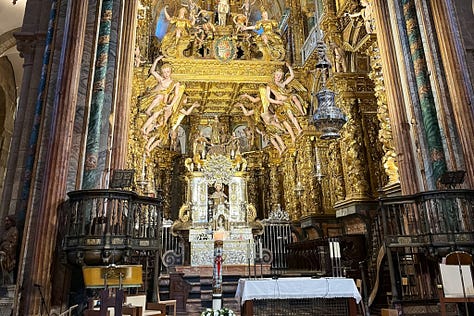



Only for me, this is not the end and my dream isn’t over. And so as the new day begins, I continue on the path going west out of the city.
This story concludes on the shores of Cape Finisterre.




